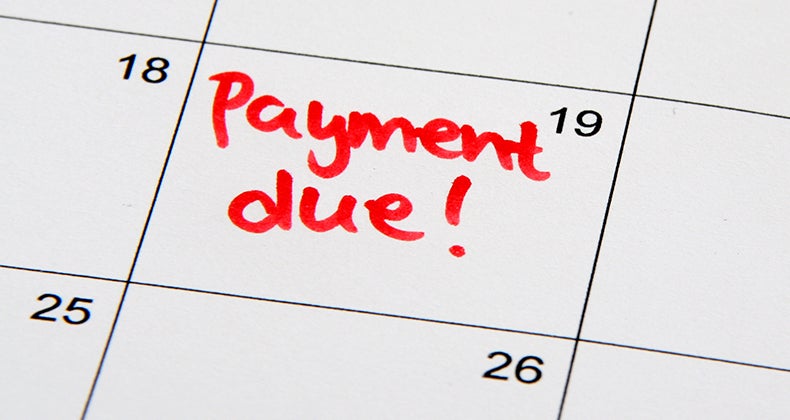Considering bankruptcy? It could cost more than you think

Key takeaways
- The federal filing fee for Chapter 7 bankruptcy currently is $338, while Chapter 13 filings cost $313.
- Additional costs are involved in filing for bankruptcy, such as attorney and credit counseling fees.
- Bankruptcy filings can stay on your credit report for up to 10 years, impacting your finances for a long time.
If you’re struggling with an overwhelming level of debt, filing for bankruptcy may be the right solution for you. However, a bankruptcy filing isn’t free. Although the amount you’ll owe may vary depending on several factors, you’ll have to pay administration costs to the court and cover your attorney’s fees.
In addition, bankruptcy can have a long-term impact on your financial prospects. Bankruptcy stays on your credit for years, which means you’ll have to deal with the consequences of a lowered credit score such as higher interest rates or more difficulty finding apartments you can rent.
Before you file for bankruptcy, you should consider these long-term and immediate costs.
Immediate costs of filing for bankruptcy
When figuring out the near-term costs of filing for bankruptcy, there are several factors to consider.
The filing fee, which starts at about $313 depending on the type of bankruptcy case you’re filing, is just one of the costs you’ll pay. You also have to pay for:
- Attorney fees: $1,000 to $,6,000
- Court fees: Variable
- Credit counseling: Available free from non-profits depending on your income, but up to $50+ elsewhere
Filing fees for Chapter 7
Chapter 7 bankruptcy involves liquidating your assets and using the proceeds to pay your creditors. These assets may include any secondary properties you own besides your primary residence, such as additional cars, recreational vehicles, boats, valuables such as jewelry, etc.
A court-appointed trustee will handle the selling of the property. Once the Chapter 7 process is complete and your creditors are satisfied, the remainder of your debt will be discharged.
Compared to Chapter 13 bankruptcy, Chapter 7 is quick. From first filing to discharge, the process takes just a few months. However, not everyone qualifies for Chapter 7. You must be able to prove a low income through a means test to file for Chapter 7.
The federal government sets the fees for a Chapter 7 bankruptcy petition. Currently, the cost is $338.
Filing fees for Chapter 13
On the other hand, Chapter 13 bankruptcy is a longer process that allows you to keep your assets. As part of Chapter 13, you can pay off your debts in a repayment plan that typically lasts three to five years. Your debts will be discharged once you have made the last payment in the plan.
As with Chapter 7, the federal government also sets the fees for Chapter 13 bankruptcy filings. Currently, the cost is $313.
Attorney fees
Aside from the initial filing fees, you’ll also need to pay your attorney if you use one. Your attorney’s fee will likely be the largest expense of the bankruptcy process.
Attorney fees vary. The rate you pay may be based on a variety of factors, including the complexity of the case and whether you’re filing for Chapter 7 or Chapter 13 bankruptcy. However, some states limit the amount that attorneys can charge for bankruptcy cases.
Typically, attorney fees for Chapter 13 cases tend to be higher than those for Chapter 7 cases. However, for filing Chapter 7 you’ll likely have to pay the entire fee upfront. With Chapter 13, you’ll be able to pay your attorney fees over time as part of the multiyear process.
The average attorney fee for a Chapter 7 bankruptcy case is about $2,000. The average Chapter 13 filer will pay anywhere from $2,500 to $3,500.
It is possible to file without an attorney, but many experts suggest it’s worth the cost. Bankruptcy judges and other court employees are prohibited from offering legal advice, as are services that prepare bankruptcy petitions for a fee. An attorney looks out for your best interests.
“It’s possible to file without an attorney, but experts warn that it can lead to mistakes that prompt the court to dismiss the case. It’s possible to file without an attorney, but experts warn that it can lead to mistakes that prompt the court to dismiss the case,” said Ed Boltz, an attorney with more than 26 years of experience. Boltz has been a certified consumer bankruptcy law specialist since 2004.
“When you hire an attorney, what you’re paying for is not just the work of preparing the case — which is complicated — and screening the case. It’s an insurance policy. When something goes wrong, you have someone there to help you take care of it.”
Credit counseling fees
The U.S. government requires everyone filing for bankruptcy to complete two credit counseling and debtor education courses. If you’re a bankruptcy filer, you’ll be responsible for paying any costs for these sessions. You can expect to pay somewhere between $10 and $50 for each course, but some agencies offer free sessions.
The courses are hosted by nonprofit credit counseling agencies, and the prices they charge are used to cover the costs of their services. The National Foundation for Credit Counseling (NFCC) website can help you locate a credit counseling agency that’s convenient for you.
Long-term costs of bankruptcy
Beyond the immediate cost of bankruptcy, filing can have a long-term impact on your financial life. The most obvious effect is that your credit score is likely to drop. However, your credit score may already be low if you’re overwhelmed with bills.
If you file for Chapter 7 bankruptcy, the event will remain on your credit report for up to 10 years. A Chapter 13 filing will remain on your record for up to seven years.
While the bankruptcy is on your credit report, you’ll likely struggle to qualify for new loans. If a lender does offer you a loan, you will usually have to pay a higher interest rate than someone with good credit. That higher interest may mean paying thousands of dollars more to buy a home or a car.
Some landlords and even certain employers may check your credit as part of your application to rent an apartment, sign up for a new phone or utility service, buy insurance or get a new job. A bankruptcy on your credit report could hurt your chances.
Factors that can affect bankruptcy costs
With both Chapter 7 and Chapter 13 bankruptcy filings, there may be additional court costs, such as fees for making copies of records, amending the filing, changing the type of filing and more. These fees are relatively minor.
Sometimes, a bankruptcy filing can also be complicated by extenuating circumstances. In certain cases, this could lead to paying higher costs. Factors include:
- If you’re filing for bankruptcy for both yourself and a business.
- If you have numerous assets
- If you have a long list of creditors.
- If you’ve recently filed for bankruptcy.
- If you have debts that can’t be discharged, such as child support payments, student loans or back taxes
- If you need to take time off from work to deal with the filing.
Depending on your state, low-income filers may qualify for a reduction in court filing fees. Check with your state’s bankruptcy court system for more information.
Alternatives to bankruptcy
For many individuals, filing for bankruptcy may be a last-ditch effort to get out from under a massive load of debt. Before filing, you may want to consider the following alternatives:
- Credit counseling: You can seek the assistance of a nonprofit credit counseling agency even without filing for bankruptcy. Trustworthy agencies can help you establish a debt management plan for a low cost that can help you pay off your debt over time without taking a serious hit to your credit score.
- Debt consolidation: Taking out a debt consolidation loan or signing up for a balance transfer credit card are other options to deal with significant debt. Using a single account to repay existing debts like credit cards, medical debt or other loans can help streamline your monthly finances and may allow you to reduce the amount of interest you’re paying.
- Debt settlement: Debt settlement involves negotiating with creditors to pay less than the total amount owed. The negotiations with creditors can be conducted by you or by a third-party company that specializes in this process. However, debt settlement can be worse for your credit and financial situation than bankruptcy and settlement carries a lot of risk, so weighing the pros and cons is important.
The bottom line
There are several costs associated with filing for bankruptcy. They include the U.S. government-set filing fee of $338 for Chapter 7 filings and $313 for Chapter 13 filings, your attorney’s fees, the cost of credit counseling and various other charges that may pop up along the way.
By knowing the costs of bankruptcy before you file, you can be better prepared to pay and expedite the bankruptcy process. However, it’s also important to keep in mind the long-term costs of a bankruptcy case, including the higher interest rates you may have to pay when you apply for a new loan, credit card or mortgage.
Frequently asked questions
Why we ask for feedback Your feedback helps us improve our content and services. It takes less than a minute to complete.
Your responses are anonymous and will only be used for improving our website.







